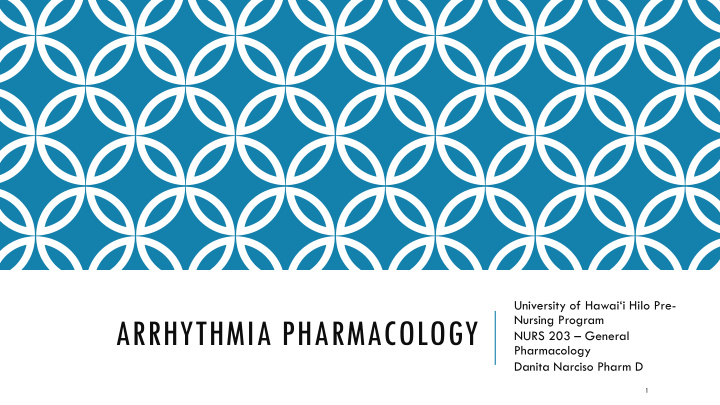



University of Hawai‘i Hilo Pre - Nursing Program ARRHYTHMIA PHARMACOLOGY NURS 203 – General Pharmacology Danita Narciso Pharm D 1
LEARNING OBJECTIVES Understand what arrhythmias are and differentiate between the different types Know the characteristics of the drugs in the different arrhythmia treatment groups Know amiodarone Know sotalol Know drug limited by side effects Know drugs with very serous side effects 2
ARRHYTHMIA What is an arrhythmia? An irregular heart beat What are the types of arrhythmias? 1. Automaticity Abnormality 2. Conductivity Abnormality Delay or Block Re-entry 3
ARRHYTHMIA – DISTURBANCE IN AUTOMATICITY Pacemaker cells: Create their own electrical impulses Do not require chemical messengers, electrical impulses, or nearby action potentials Regular heart rate is 60-100 bpm Decrease in pacemaker activity Pacemaker cells have Bradycardia (less than 60 bpm) AUTOMATICITY Increase in pacemaker activity Tachycardia (more than 100 bpm) Ectopic pacemaker activity Impulse formation in the SA node happens “regularly” Shift in the impulse formation creates “irregular” rate or rhythm 4
ARRHYTHMIA – DISTURBANCES OF CONDUCTIVITY AV block 2nd 1st SA Block 3rd 5
ARRHYTHMIA – RE-ENTRY • Re-entry is responsible for ectopic beats • Most common type of arrhythmia • Ectopic beats – begin A. Normal impulse somewhere other than the SA node 6
ARRHYTHMIAS – HOW DO WE TREAT? There are 4 groups of anit-arrhythmic drugs Group I Drugs Group II Drugs Fast sodium channel blockers Beta blockers Increase the refractory period Slow the heart rate Slow the heart rate Reduce SNS stimulation Group IV Drugs Block calcium channels Group III Drugs Decrease automaticity Prolong cardiac repolarization Decrease smooth muscle & cardiac contraction Decrease conduction velocity 7
ARRHYTHMIA – GROUP I DRUGS Group I A Group I Drugs Disopyramide, procainamide, quinidine Fast sodium channel blockers Interfere Na influx at phase 0 Increase the refractory period Slows the speed of depolarization Slow the heart rate Slows conduction velocity Widened QRS/prolonged QT on EKG Group I B Group I C Lidocaine, tocainide, mexiletine Flecainide & propafenone Increase or no effect on conduction Used for life threatening supraventricular velocity tachyarrhythmias Mexiletine limited by ADRs Can cause sinus arrest – use with extreme Tocainide can cause agranulocytosis caution 8
ARRHYTHMIA – GROUP I DRUGS Group I A Disopyramide, procainamide, quinidine Group I Drugs Fast sodium channel blockers Increase the refractory period Slow the heart rate Widened QRS/prolonged QT on EKG Group I C Group I B Agranulocytosis = Decreased WBC neutrophil deficiency (neutropenia) decreased ability to fight infection (tocainide) 9
ARRHYTHMIA – GROUP II DRUGS (BETA BLOCKERS) Acebutolol Esmolol Beta 1 selective with modest ISA Beta 1 selective Used for: Ventricular dysrhythmia Very short acting Can stop ectopic beats Used for: Atrial fibrillation/flutter, Angina and HTN supraventricular tachycardia (SVT), operative HTN High first pass effect IV bolus and infusion ADRs: Can cause AV block ADRs: Nausea, hypotension, sweating 10
ARRHYTHMIA – GROUP III Prolong the refractory period DRUGS Time until the next depolarization Bretylium Block potassium channels Amiodarone Dofetilide Sotalol Prolong QT interval – can cause ventricular dysrhythmias 11
ARRHYTHMIA – GROUP III MOA: Increase refractory period all cardiac tissues, decrease automaticity, prolong AV DRUGS conduction, decrease automaticity in Purkinje fibers Uses: Life threatening ventricular fibrillation Amiodarone – most and ventricular tachycardia, atrial fibrillation conversion to NSR, paroxysmal commonly used supraventricular tachycardia (PSVT) MAJOR ENZYME INHIBITOR (GPACMAN) group III agent M Substrate for CYP enzymes I Long half life (26-107days) O D ADRs: Bradycardia, heart block A heart failure, hepatic & R pulmonary toxicity, dizziness, O visual disturbances, etc. N E 12
ARRHYTHMIA – GROUP III Used for: Life threatening ventricular arrhythmias DRUGS Betapace AF – afib Sotalol – unusual Well absorbed, excreted in urine as unchanged drug beta 1 selective ADRs: Torsades de pointes / QT prolongation and fatigue, dizziness, agent that also weakness, dyspnea, confusion, headache, N&V blocks potassium channels 13
QUESTIONS 14
Recommend
More recommend